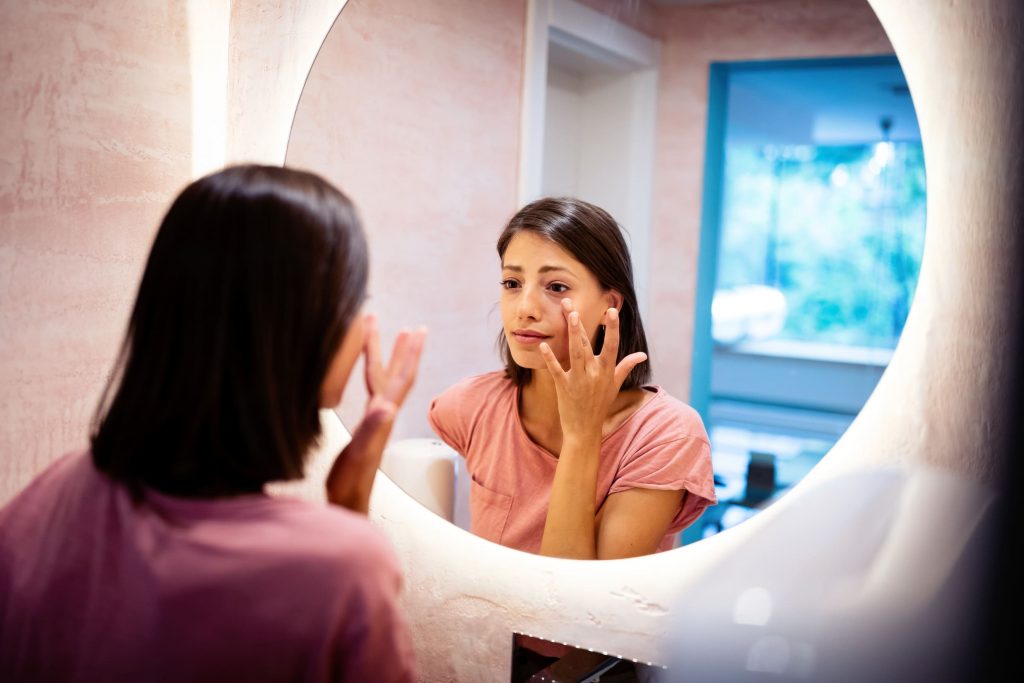How To Clear Acne Quickly And Safely
Acne is one of the most common skin conditions in the world, affecting adolescents and adults even if they didn’t have teenage acne. How we treat acne has evolved over the years as we learn more about the skin and its various conditions.
Acne isn’t caused by a lack of hygiene or ‘dirty’ skin – so no amount of cleansing, scrubbing, or exfoliating will clear up your breakouts. In fact, excessive cleansing and exfoliating can inflame the skin and make it worse! Acne is a medical condition that needs a medical solution to clear up and manage.
Acne doesn’t just occur on your face – it can appear on your chest and back (and sometimes your upper arms) as these areas have many sebaceous glands.

What Is Acne?
Acne is not a cosmetic condition, but a chronic inflammatory disease, and can be anything from clogged pores called ‘comedones’, which can be open (blackheads) or closed (whiteheads), papules (small red bumps on the skin), and pustules (like papules but filled with pus), to very large, painful, inflamed and swollen nodules and cysts (‘blind pimples’). Redness and pain, as well as resulting hyperpigmentation and scarring, are also common with acne.
How does acne start? It all begins with a clogged pore. Acne sufferers produce excess oil (‘sebum’) and the skin cells lining their pores don’t shed properly, instead they collect in the pore. The sticky skin cells and oil mix together along the length of the pore, creating a microscopic blockage called a microcomedone.
Acne bacteria (Cutibacterium acnes, which used to be called Propionibacterium acnes) feed on sebum, gathering and multiplying in large numbers around the oily plug, which signals to the body that it should start producing chemicals that result in inflammation.
The inflamed plug gradually enlarges to form a visible comedone. In some instances, the comedone can burst, resulting in the bacteria and pus leaking out onto the surrounding tissue, creating even more inflammation, and causing other acne lesions like papules, pustules, nodules, and cysts.
Do Hormones Cause Acne?
Excess sebum production (‘seborrhoea’) is caused by hormones. The hormones involved are called ‘androgens’, and include dihydrotestosterone (DHT) and testosterone. Both males and females produce androgens in their adrenal glands, testes or ovaries, or these are converted from precursor chemicals in the skin, hair follicles, sweat glands, and sebaceous glands.
Teenage acne occurs as a result of the natural increase in androgen hormones during puberty, but adult acne is more common than you think – it can flare during menstruation (it is thought that this is because less oestrogen is available to suppress androgens), and pregnancy.
Because of its hormonal basis, treatments for acne can include anti-androgen drugs such as oral contraceptives, spironolactone, and cyproterone acetate. Vitamin A can also reduce sebaceous gland activity.
Acne Treatments
From over the counter (OTC) remedies to custom formulated prescription treatments from telehealth providers, there are more than enough ways to treat and prevent acne from returning. When browsing the shelves of skin care you will find acne cleansers and acne treatments aimed at unclogging pores (usually with salicylic acid and glycolic acid) and killing bacteria (benzoyl peroxide, which also has a pore unclogging effect). These often don’t fully clear breakouts because they don’t target all the factors that cause acne – oil, excess skin cells, bacteria, and inflammation.
Clinically formulated treatments can be found through telehealth providers whose doctors can customise the best acne treatment product for you – one that can help you correctly identify and target all the acne-causing pathways to help you rid your skin of acne (and post-inflammatory hyperpigmentation at the same time). Qr8 MediSkin does just that, with a video consultation with a doctor and direct delivery of your treatment to your door, there is no need to visit an acne dermatologist or wait in line at the pharmacy!

The Best Acne Treatment Ingredients
AZELAIC ACID
This naturally-occurring acid is derived from rye, wheat and barley (although typically made in a lab from vegetable oils). Azelaic acid acts as an antioxidant, anti-inflammatory, anti-bacterial and depigmenting agent.
The anti-inflammatory action of azelaic acid, combined with its anti-bacterial and pore unblocking functions, makes it a great treatment for mild to moderate acne, especially when combined with a prescription retinoid.
VITAMIN B3
Also called niacinamide, vitamin B3 has anti-inflammatory, skin barrier lipid regulating, sebum-regulating, depigmenting, antimicrobial and photo-protective effects (phew!) when applied topically. It is very well tolerated – so well in fact that you will find it in many readily available cosmetic and over the counter skin care products.
TAZAROTENE
Tazarotene produces similar effects to tretinoin, but it has a more selective action than tretinoin, only binding to specific nuclear retinoic acid receptors (RARs). In practical terms, this means that tazarotene decreases acne papules and open comedones (blackheads) at a more rapid rate than tretinoin.
Finding The Right Acne Cream For Your Type of Acne
Treating the different types of acne can take many forms, from peels and toners to creams and serums. Simplify your skincare routine and stay away from over cleansing or exfoliating with manual or chemical exfoliants.
With over the counter remedies, while they are easily accessible in drug and beauty stores you will not see the same results that you would get if you were prescribed acne treatment from a doctor or dermatologist. Consulting a medical professional will take away most of the guesswork, as well as the trial and error that is common when attempting to treat and prevent acne.
